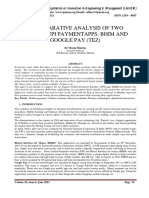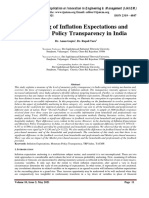Preprocessing The Informal Text For Efficient Sentiment Analysis
Preprocessing The Informal Text For Efficient Sentiment Analysis
International Journal of Emerging Trends & Technology in Computer Science (IJETTCS)
Web Site: www.ijettcs.org Email: editor@ijettcs.org, editorijettcs@gmail.com Volume 1, Issue 2, July August 2012 ISSN 2278-6856
Preprocessing the Informal Text for efficient Sentiment Analysis
I.Hemalatha1
1
Dr. G. P Saradhi Varma2
Dr. A.Govardhan3
Research Scholar JNT University Kakinada, Kakinada, A.P.,India.
Professor & Head, Dept., of Information Technology, S.R.K.R. Engineering College, Bhimavaram, A.P.,India.
3
Director of Evaluation JNT University, Hyderabad, A.P.,India.
Abstract: Social networking sites are increasing rapidly in
this global world where communication plays a major role. There is drastic increase in the usage of social networking sites among all age groups. This can be used for business development, reviews about various social activities and acceptance of any new ideas by means of Sentiment Analysis. Thus for sentiment analysis, preprocessing is an essential task. The reviews by the user represents valuable approaching of sentiment analysis. This research paper focuses on the preprocessing techniques implemented on a specially designed algorithms in order to perform sentiment analysis.
generally confined to 140 words unlike other social networking sites where the review may contain large number of words.
3. TWITTER DATA
Twitter is a real-time information network that connects you to the latest stories, ideas, opinions and news about what you find interesting. Simply find the accounts you find most compelling and follow the conversations. At the heart of Twitter are small bursts of information called Tweets. Each Tweet is 140 characters long, but dont let the small size fool youyou can discover a lot in a little space. You can see photos, videos and conversations directly in Tweets to get the whole story at a glance, and all in one place.
Keywords: Web mining analysis, classification.
preprocessing,
sentiment
1. INTRODUCTION
The rapid growth of the Communication and Information Technology has made information broadcast very critical. The social networks, in particular, continues to play a major role in the passing of information and as well as business intelligence. To get any information, we need a social networking sites. This sites can offer valuable information imminent into the Sentiment analysis of a particular product or a movie. It represent the action of many users over a product through positive and negative reviews. Most organizations identify these reviews as an important part of their decision making. Social networks reviews can be effectively applied to sentiment analysis of information. Properly identified reviews present a baseline of information that indicates ideal levels and supports the business intelligence. It also supports in business decisions. This research paper explains the necessary information to get preprocess the reviews in order to find sentiment and confirm its analysis whether it is positive or negative. 2. SOCIAL NETWORKING SITES 2.1 Background Social networking sites are playing a crucial role in every aspect and in all corners of the world. Many social networking sites like facebook, twitter, myspace etc., are extensively used now a days. We used tweets from twitter to carry our research work. This is because tweets are Volume 1, Issue 2 July-August 2012
4. METHODOLOGY
4.1 Twitter Tweets The below table shows reviews by different people about the apple product. Table 1 Tweets by users
kvkruthika: im the lucky few to own brand new unlaunched (in India) APPLE I-PHONE 5S model...:) :) :) :) :) :) i'm loving it...!!! YourLeader_: Dear Apple, y tf is my iPhone's USB cord so short?! Signed, Irked linderxlum4: CarrieSBitz I don't do apple so can't comment on that. I use cisco/Linksys and seem to replace route MistahBungle: @jonfortt Yours is biased Jonny. You love Apple. Admit it. LilMamaRollsUp: I don't have nobody to impress out at apple blossom , so I don't need to make myself all up *shrugs* lls RichardZimmer: @iRyan77 Buy anything at Apple?
Page 58
International Journal of Emerging Trends & Technology in Computer Science (IJETTCS)
Web Site: www.ijettcs.org Email: editor@ijettcs.org, editorijettcs@gmail.com Volume 1, Issue 2, July August 2012 ISSN 2278-6856
4.2 Preprocessing
5. SENTIMENT ANALYSIS BASED ON SENTIWORDNET
The approach described in this paper is based on SentiWordNet, a lexical resource for opinion mining. In SentiWordNet (http://sentiwordnet.isti.cnr.it/), to each synset of WordNet, a triple of polarity scores is assigned i.e., a positivity, negativity and objectivity score. The sum of these scores is always 1. For example the triple {0, 1, 0} (positivity, negativity, objectivity) is assigned to the synset of the term bad. The sum of all scores of this synset is 1. SentiWordNet has been created automatically by means of a combination of linguistic and statistic classifiers. It has been applied in different opinion-related tasks, i.e. for subjectivity analysis and sentiment analysis with promising results. 5.1 Bigrams Bigrams are used in order to increase the accuracy of the classifier. The effect of previous word on current word plays major role in sentiment analysis hence we consider bigrams rather than unigrams. In general preceding word will show more effect on the current word rather than the succeeding word hence we consider the polarity of preceding word. For example consider the sentence The art shows the culture and social issues prevailing at that point of time. Bigrams can be done as follows The art, art shows, shows the, culture and, and social, social issues, issues prevailing , prevailing at, and so on.
Figure1 Preprocessing of Informal Text Data preprocessing is done to eliminate the incomplete, noisy and inconsistent data. Data must be preprocessed in order to perform any data mining functionality. Data Preprocessing involves the following tasks Removing URLs In general URLs does not contribute to analyze the sentiment in the informal text. For example consider the sentence I have logged in to www.Ecstasy.com as Im bored actually the above sentence is negative but because of the presence of the word ecstasy it may become neutral and its a false prediction. In order to avoid this sort of failures we must employ a technique to remove URLs. Filtering Usually people use repeated letters in words like happyyyyy to show their intensity of expression. But, these word are not present in the sentiwordnet hence the extra letters in the word must be eliminated. This elimination follows the rule that a letter cant repeat more than three times hence can eliminate such letter. Questions The question words like what, which, how etc., are not going to contribute to polarity hence in order to reduce the complexity such words are removed. Removing Special Characters Special characters like.,[]{}()/ should be removed in order to remove discrepancies during the assignment of polarity. For example its good: if the special characters are not removed sometimes the special characters may concatenate with the words and make those words unavailable in the dictionary. In order to overcome this we remove special characters. Removal of Retweets. Retweeting is the process of copying another user's tweet and posting to another account. This usually happens if a user likes another user's tweet. Retweets are commonly abbreviated with \RT." For example, consider the following tweet: Awesome! RT @rupertgrintnet Harry Potter Marks Place in Film History http://bit.ly/Eusxi :).
6. SES ALGORITHM FOR PREPROCESSED DATA TO CALCULATE SENTIMENT
Step 1: Assign a weight to each word from the SentiWordNet dictionary Step 2: Sentence level polarity is calculated as consider the sentences to calculate the average score Step 3: check (sent_sentim_word + 3) and (sent_sentim_word - 3) for Modifier from modifier_dict if word found as modifier then calculate overall weight. Step 4: If there is negation word (Not, Never, Nt, Doesnt, Cannt, Nor, Dont, Wouldnt, No) near the N, Check (N+3) and (N-3) then reverse its polarity. e.g. (OW=+0.8 OM= -0.8) Step 5: Check the modifier word in the sentence, if exists then recalculate the polarity referring the weightage dictionary the same process will be repeated that score of which opinion word will be effected. For e.g, in the sentence the staff were very nice and cooperative, in this sentence the very is enhance the weight of the nearest opinion word i.e., nice Step 6: Certain nouns affect the sentence polarity, so recalculate the polarity if such types of word occur. From Page 59
Volume 1, Issue 2 July-August 2012
International Journal of Emerging Trends & Technology in Computer Science (IJETTCS)
Web Site: www.ijettcs.org Email: editor@ijettcs.org, editorijettcs@gmail.com Volume 1, Issue 2, July August 2012 ISSN 2278-6856
the dictionary of the weights of words/terms, assign weights to each sentence accordingly. The steps of rule base system for contextual valance shifter is describes as below: if the modifier is a negation modifier then sentim_word_score:= Reverse the polarity of sent_sentim_word if the modifier is a intensifier then sentim_word_score:= sentim_word_score + modifier_weight if the modifier is a decelerator or enhancer or context shifter then sentim_word_score:= intensifying modifier_weight obtained from modifier_dict Calculate the final weights of each sentence and review to decide if it is positive, negative or neutral. So, the opinion strength for both sentence and feedback is calculated by assigning the combined opinion weight to the sentence and review using the Eq. 3 and 4: SentenceScore(Sen)= ...Eq.3 Where, Score (Sen), are the positive or negative score of sentence Sen, Score(i) is the positive, negative score of ith word in sentence S. n is the total no. of words in Sen: ReviewScore(Rew)= ...Eq.4 Where, Rew(Score), are the positive or negative score of Review Rew, Score(Sen) are the positive, negative score of ith sentences in review. n is the total no. of sentences in the review.
8. CONCLUSION
In this paper, we have proposed an efficient method for preprocessing. Where it has to be done before applying any classification algorithm. We have performed three preprocessing tasks. One task to remove URLs from the input file next one to remove special characters, here we can also remove repeated letters from a word, the last task is to remove question words. Now the preprocessed document can be given as input to any Machine Learning algorithms. REFERENCES [1]. Document-Word Co-Regularization for Semisupervised Sentiment Analysis by Vikas Sindhwani and Prem Melville, Business Analytics and Mathematical Sciences, IBM T.J. Watson Research Center, Yorktown Heights, NY 10598 {vsindhw,pmelvil}@us.ibm.com [2]. Fully Automatic Lexicon Expansion for Domainoriented Sentiment Analysis by Hiroshi Kanayama Tetsuya Nasukawa, Tokyo Research Laboratory, IBM Japan, Ltd. 1623-14 Shimotsuruma, Yamato-shi, Kanagawa-ken, 2428502 Japan {hkana,nasukawa}@jp.ibm.com [3]. LargeScale Sentiment Analysis for News and Blogs Namrata Godbole? Manjunath Srinivasaiah? Steven Skiena_namratagodbole@gmail.com manj.blr@gmail.com skiena@cs.sunysb.edu?Google Inc., New York NY, USA}Dept. of Computer Science, Stony Brook University, Stony Brook, NY 11794-4400, USA [4]. Language processing Techniques - IBM Tokyo Research Lab, 1623-14, Shimotsuruma Yamatoshi, Kanagawa-ken 242-8502, Japan nasukawa@ip.ibm.com [5]. Sentiment Elicitation System for Social Media Data Kunpeng Zhang, Yu Cheng, Yusheng Xie, Daniel Honbo Ankit Agrawal, Diana Palsetia, Kathy Lee, Wei-keng Liao, and Alok Choudhary - Department of Electric Engineering & Computer Science, Northwestern University, Evanston, IL 60208, [6]. Sentiment Analysis in Practice Yongzheng (Tiger) Zhang , Dan Shen*, Catherine Baudin [7]. Sentiment Analysisin Short and Informal Text Marco Veluscek with the supervision of Prof. Sune Lehmann, PhD [8]. Text normalization in social media: progress, problems and applications for a pre-processing system of casual English - Eleanor Clarka* and Kenji Arakia Pre-processing very noisy text - Alexander Clark, ISSCO / TIM, University of Geneva, UNI-MAIL, Boulevard du Pont-dArve, CH-1211 Geneva 4, Switzerland. Page 60
7. EXPERIMENTS AND RESULTS
The sample of results obtained from each intermediate step of the proposed approach is given in this section. For providing sample results, we take 100 reviews from twitter. The reviews are initially subjected to preprocessing which includes Removing URLs, Filtering, Questions and Removing Special Characters. Preprocessing results in reviews represented. The reviews and preprocessing results are given in the figure 1.
Figure 1 Preprocessing window that displays results of corresponding tasks Volume 1, Issue 2 July-August 2012
International Journal of Emerging Trends & Technology in Computer Science (IJETTCS)
Web Site: www.ijettcs.org Email: editor@ijettcs.org, editorijettcs@gmail.com Volume 1, Issue 2, July August 2012 ISSN 2278-6856
I.Hemalatha received her M.Tech degree from Andhra University, pursuing Ph.D in computer Science Engineering. A member of CSI, Co-ordinator for Microsoft Student Education Academy, Member in Infosys Campus connect Programme. Working as Assistant Professor in S.R.K.R. Engineering College, China-Amiram, Bhimavaram.
Volume 1, Issue 2 July-August 2012
Page 61
You might also like
- Mathematics: Quarter 2 - Module 5 Sector and Segment of A Circle86% (7)Mathematics: Quarter 2 - Module 5 Sector and Segment of A Circle7 pages
- Motor Learning and Control 9th Edition Test Bank Richard A Magill100% (52)Motor Learning and Control 9th Edition Test Bank Richard A Magill4 pages
- Ericsson RBS 6201 WCDMA 2100MHz Cabinet PDFNo ratings yetEricsson RBS 6201 WCDMA 2100MHz Cabinet PDF2 pages
- Students' Satisfaction With Hostel Facilities in Federal University of Technology Akure Nigeria PDFNo ratings yetStudents' Satisfaction With Hostel Facilities in Federal University of Technology Akure Nigeria PDF14 pages
- The Relationship of Cash Conversion Cycle With Firm SizeNo ratings yetThe Relationship of Cash Conversion Cycle With Firm Size8 pages
- RBS Series Macro Base Stations: Public Safety LteNo ratings yetRBS Series Macro Base Stations: Public Safety Lte5 pages
- P02 - Procedure For Handling The RBS External & Internal AlarmsNo ratings yetP02 - Procedure For Handling The RBS External & Internal Alarms3 pages
- An Experimental Study of Text Preprocessing Techniques For Automatic Short Answer Grading in IndonesianNo ratings yetAn Experimental Study of Text Preprocessing Techniques For Automatic Short Answer Grading in Indonesian5 pages
- Ericsson W-Cdma/Lte 2100Mhz Remote Radio Unit 120W (2 X 60W) KRC 161 349/2 R1B Model Rrus12 B4 April 2015No ratings yetEricsson W-Cdma/Lte 2100Mhz Remote Radio Unit 120W (2 X 60W) KRC 161 349/2 R1B Model Rrus12 B4 April 20157 pages
- L900 Wiring Diagram - Part of 2679 - PA8No ratings yetL900 Wiring Diagram - Part of 2679 - PA848 pages
- RBS 6201/6202 & BBS/BBU 6201 Installation: RAN System Description and RBS 6000 SurveyNo ratings yetRBS 6201/6202 & BBS/BBU 6201 Installation: RAN System Description and RBS 6000 Survey22 pages
- 2 Ericsson Rrus12 b4 2100mhz Tda 2015 TocNo ratings yet2 Ericsson Rrus12 b4 2100mhz Tda 2015 Toc7 pages
- Final Term Examination SPRING 2007 Cs101 - Introduction To Computing (Session - 3)No ratings yetFinal Term Examination SPRING 2007 Cs101 - Introduction To Computing (Session - 3)7 pages
- L900 Wiring Diagram - Part of 2679 - PA9No ratings yetL900 Wiring Diagram - Part of 2679 - PA950 pages
- Current Analysis Ericsson RBS6000 eNodeB Report - 53792100% (1)Current Analysis Ericsson RBS6000 eNodeB Report - 537926 pages
- Site Quality Acceptance Certificate: Manager Service Quality Assurance Kalimantan RANQ, Escalation EricssonNo ratings yetSite Quality Acceptance Certificate: Manager Service Quality Assurance Kalimantan RANQ, Escalation Ericsson6 pages
- User Description, BSS File Definitions - STS and Recording FunctionsNo ratings yetUser Description, BSS File Definitions - STS and Recording Functions8 pages
- UTRAN Interfaces and Protocol StructureNo ratings yetUTRAN Interfaces and Protocol Structure10 pages
- Commisioning & FormatBaseBand 5212-5216-6630No ratings yetCommisioning & FormatBaseBand 5212-5216-66301 page
- Multi-Standard Main-Remote Base Station Next Generation Zero FootprintNo ratings yetMulti-Standard Main-Remote Base Station Next Generation Zero Footprint2 pages
- Principles of Database Management Overview100% (1)Principles of Database Management Overview24 pages
- ! ANITE Guideline - RF Tuning by Measurements V2 - 0No ratings yet! ANITE Guideline - RF Tuning by Measurements V2 - 0146 pages
- 24pp Radiaflex Brochure Update1 2013-06No ratings yet24pp Radiaflex Brochure Update1 2013-0624 pages
- Study of Uplink Interference in UMTS Network PDFNo ratings yetStudy of Uplink Interference in UMTS Network PDF13 pages
- Sentiment Analysis of A Product Based On User Reviews Using Random Forests AlgorithmNo ratings yetSentiment Analysis of A Product Based On User Reviews Using Random Forests Algorithm5 pages
- Sentiment Analysis of Twitter Data: A Survey of Techniques: Vishal A. Kharde S.S. SonawaneNo ratings yetSentiment Analysis of Twitter Data: A Survey of Techniques: Vishal A. Kharde S.S. Sonawane11 pages
- Sentiment Analysis of Tweets Using Python: Dr. Ritesh Srivastava, Bharat Singh, Choudhary Rishab Kumar, Prashant RajNo ratings yetSentiment Analysis of Tweets Using Python: Dr. Ritesh Srivastava, Bharat Singh, Choudhary Rishab Kumar, Prashant Raj4 pages
- Detection of Malicious Web Contents Using Machine and Deep Learning ApproachesNo ratings yetDetection of Malicious Web Contents Using Machine and Deep Learning Approaches6 pages
- Customer Satisfaction A Pillar of Total Quality ManagementNo ratings yetCustomer Satisfaction A Pillar of Total Quality Management9 pages
- THE TOPOLOGICAL INDICES AND PHYSICAL PROPERTIES OF n-HEPTANE ISOMERSNo ratings yetTHE TOPOLOGICAL INDICES AND PHYSICAL PROPERTIES OF n-HEPTANE ISOMERS7 pages
- Study of Customer Experience and Uses of Uber Cab Services in MumbaiNo ratings yetStudy of Customer Experience and Uses of Uber Cab Services in Mumbai12 pages
- An Importance and Advancement of QSAR Parameters in Modern Drug Design: A ReviewNo ratings yetAn Importance and Advancement of QSAR Parameters in Modern Drug Design: A Review9 pages
- An Importance and Advancement of QSAR Parameters in Modern Drug Design: A ReviewNo ratings yetAn Importance and Advancement of QSAR Parameters in Modern Drug Design: A Review9 pages
- Analysis of Product Reliability Using Failure Mode Effect Critical Analysis (FMECA) - Case StudyNo ratings yetAnalysis of Product Reliability Using Failure Mode Effect Critical Analysis (FMECA) - Case Study6 pages
- Detection of Malicious Web Contents Using Machine and Deep Learning ApproachesNo ratings yetDetection of Malicious Web Contents Using Machine and Deep Learning Approaches6 pages
- Study of Customer Experience and Uses of Uber Cab Services in MumbaiNo ratings yetStudy of Customer Experience and Uses of Uber Cab Services in Mumbai12 pages
- Soil Stabilization of Road by Using Spent WashNo ratings yetSoil Stabilization of Road by Using Spent Wash7 pages
- The Mexican Innovation System: A System's Dynamics PerspectiveNo ratings yetThe Mexican Innovation System: A System's Dynamics Perspective12 pages
- The Impact of Effective Communication To Enhance Management SkillsNo ratings yetThe Impact of Effective Communication To Enhance Management Skills6 pages
- Design and Detection of Fruits and Vegetable Spoiled Detetction SystemNo ratings yetDesign and Detection of Fruits and Vegetable Spoiled Detetction System8 pages
- Staycation As A Marketing Tool For Survival Post Covid-19 in Five Star Hotels in Pune CityNo ratings yetStaycation As A Marketing Tool For Survival Post Covid-19 in Five Star Hotels in Pune City10 pages
- A Comparative Analysis of Two Biggest Upi Paymentapps: Bhim and Google Pay (Tez)No ratings yetA Comparative Analysis of Two Biggest Upi Paymentapps: Bhim and Google Pay (Tez)10 pages
- A Deep Learning Based Assistant For The Visually ImpairedNo ratings yetA Deep Learning Based Assistant For The Visually Impaired11 pages
- Performance of Short Transmission Line Using Mathematical MethodNo ratings yetPerformance of Short Transmission Line Using Mathematical Method8 pages
- Impact of Covid-19 On Employment Opportunities For Fresh Graduates in Hospitality &tourism IndustryNo ratings yetImpact of Covid-19 On Employment Opportunities For Fresh Graduates in Hospitality &tourism Industry8 pages
- Application of Mersey Silt As Fine Aggregate in ConcreteNo ratings yetApplication of Mersey Silt As Fine Aggregate in Concrete9 pages
- Design and Manufacturing of 6V 120ah Battery Container Mould For Train Lighting ApplicationNo ratings yetDesign and Manufacturing of 6V 120ah Battery Container Mould For Train Lighting Application13 pages
- Anchoring of Inflation Expectations and Monetary Policy Transparency in IndiaNo ratings yetAnchoring of Inflation Expectations and Monetary Policy Transparency in India9 pages
- Swot Analysis of Backwater Tourism With Special Reference To Alappuzha DistrictNo ratings yetSwot Analysis of Backwater Tourism With Special Reference To Alappuzha District5 pages
- Marco Economic Sustainability in India: Partisan Theory ApproachNo ratings yetMarco Economic Sustainability in India: Partisan Theory Approach7 pages
- The Effect of Work Involvement and Work Stress On Employee Performance: A Case Study of Forged Wheel Plant, IndiaNo ratings yetThe Effect of Work Involvement and Work Stress On Employee Performance: A Case Study of Forged Wheel Plant, India5 pages
- Analysis of RCC Beam Using GFRP Wrapped With Cellular StirrupsNo ratings yetAnalysis of RCC Beam Using GFRP Wrapped With Cellular Stirrups11 pages
- Call Come Do Get Give Go Have Keep Lose Pull Put Take Ring Stick TimeNo ratings yetCall Come Do Get Give Go Have Keep Lose Pull Put Take Ring Stick Time7 pages
- Present Perfect Simple Vs Present Perfect Continuous PPT GE 5100% (1)Present Perfect Simple Vs Present Perfect Continuous PPT GE 511 pages
- Tuesday Grammar - Explanation Text FeaturesNo ratings yetTuesday Grammar - Explanation Text Features7 pages
- Jane Baun, A. Cameron, M. Edwards, Markus Vinzent-Studia Patristica. Volume XLVI - Tertullian To Tyconius, Egypt Before Nicaea, Athanasius and His Opponents-Peeters Publishers (2010)100% (1)Jane Baun, A. Cameron, M. Edwards, Markus Vinzent-Studia Patristica. Volume XLVI - Tertullian To Tyconius, Egypt Before Nicaea, Athanasius and His Opponents-Peeters Publishers (2010)382 pages
- Yokouchi - 2023 - PRL - Giant Magnetochiral Anisotropy in Weyl Semimetal (WTe2) Induced by Diverging Berry CurvatureNo ratings yetYokouchi - 2023 - PRL - Giant Magnetochiral Anisotropy in Weyl Semimetal (WTe2) Induced by Diverging Berry Curvature6 pages
- The Pearl 14th Century English Poem Giovanni Boccaccio 1313-1375 Sir Israel Gollancz 1921No ratings yetThe Pearl 14th Century English Poem Giovanni Boccaccio 1313-1375 Sir Israel Gollancz 1921362 pages
- ? Week 01 - Task Assignment - Introducing MyselfNo ratings yet? Week 01 - Task Assignment - Introducing Myself9 pages
- Mathematics: Quarter 2 - Module 5 Sector and Segment of A CircleMathematics: Quarter 2 - Module 5 Sector and Segment of A Circle
- Motor Learning and Control 9th Edition Test Bank Richard A MagillMotor Learning and Control 9th Edition Test Bank Richard A Magill
- Students' Satisfaction With Hostel Facilities in Federal University of Technology Akure Nigeria PDFStudents' Satisfaction With Hostel Facilities in Federal University of Technology Akure Nigeria PDF
- The Relationship of Cash Conversion Cycle With Firm SizeThe Relationship of Cash Conversion Cycle With Firm Size
- P02 - Procedure For Handling The RBS External & Internal AlarmsP02 - Procedure For Handling The RBS External & Internal Alarms
- An Experimental Study of Text Preprocessing Techniques For Automatic Short Answer Grading in IndonesianAn Experimental Study of Text Preprocessing Techniques For Automatic Short Answer Grading in Indonesian
- Ericsson W-Cdma/Lte 2100Mhz Remote Radio Unit 120W (2 X 60W) KRC 161 349/2 R1B Model Rrus12 B4 April 2015Ericsson W-Cdma/Lte 2100Mhz Remote Radio Unit 120W (2 X 60W) KRC 161 349/2 R1B Model Rrus12 B4 April 2015
- RBS 6201/6202 & BBS/BBU 6201 Installation: RAN System Description and RBS 6000 SurveyRBS 6201/6202 & BBS/BBU 6201 Installation: RAN System Description and RBS 6000 Survey
- Final Term Examination SPRING 2007 Cs101 - Introduction To Computing (Session - 3)Final Term Examination SPRING 2007 Cs101 - Introduction To Computing (Session - 3)
- Current Analysis Ericsson RBS6000 eNodeB Report - 53792Current Analysis Ericsson RBS6000 eNodeB Report - 53792
- Site Quality Acceptance Certificate: Manager Service Quality Assurance Kalimantan RANQ, Escalation EricssonSite Quality Acceptance Certificate: Manager Service Quality Assurance Kalimantan RANQ, Escalation Ericsson
- User Description, BSS File Definitions - STS and Recording FunctionsUser Description, BSS File Definitions - STS and Recording Functions
- Multi-Standard Main-Remote Base Station Next Generation Zero FootprintMulti-Standard Main-Remote Base Station Next Generation Zero Footprint
- ! ANITE Guideline - RF Tuning by Measurements V2 - 0! ANITE Guideline - RF Tuning by Measurements V2 - 0
- Sentiment Analysis of A Product Based On User Reviews Using Random Forests AlgorithmSentiment Analysis of A Product Based On User Reviews Using Random Forests Algorithm
- Sentiment Analysis of Twitter Data: A Survey of Techniques: Vishal A. Kharde S.S. SonawaneSentiment Analysis of Twitter Data: A Survey of Techniques: Vishal A. Kharde S.S. Sonawane
- Sentiment Analysis of Tweets Using Python: Dr. Ritesh Srivastava, Bharat Singh, Choudhary Rishab Kumar, Prashant RajSentiment Analysis of Tweets Using Python: Dr. Ritesh Srivastava, Bharat Singh, Choudhary Rishab Kumar, Prashant Raj
- Detection of Malicious Web Contents Using Machine and Deep Learning ApproachesDetection of Malicious Web Contents Using Machine and Deep Learning Approaches
- Customer Satisfaction A Pillar of Total Quality ManagementCustomer Satisfaction A Pillar of Total Quality Management
- THE TOPOLOGICAL INDICES AND PHYSICAL PROPERTIES OF n-HEPTANE ISOMERSTHE TOPOLOGICAL INDICES AND PHYSICAL PROPERTIES OF n-HEPTANE ISOMERS
- Study of Customer Experience and Uses of Uber Cab Services in MumbaiStudy of Customer Experience and Uses of Uber Cab Services in Mumbai
- An Importance and Advancement of QSAR Parameters in Modern Drug Design: A ReviewAn Importance and Advancement of QSAR Parameters in Modern Drug Design: A Review
- An Importance and Advancement of QSAR Parameters in Modern Drug Design: A ReviewAn Importance and Advancement of QSAR Parameters in Modern Drug Design: A Review
- Analysis of Product Reliability Using Failure Mode Effect Critical Analysis (FMECA) - Case StudyAnalysis of Product Reliability Using Failure Mode Effect Critical Analysis (FMECA) - Case Study
- Detection of Malicious Web Contents Using Machine and Deep Learning ApproachesDetection of Malicious Web Contents Using Machine and Deep Learning Approaches
- Study of Customer Experience and Uses of Uber Cab Services in MumbaiStudy of Customer Experience and Uses of Uber Cab Services in Mumbai
- The Mexican Innovation System: A System's Dynamics PerspectiveThe Mexican Innovation System: A System's Dynamics Perspective
- The Impact of Effective Communication To Enhance Management SkillsThe Impact of Effective Communication To Enhance Management Skills
- Design and Detection of Fruits and Vegetable Spoiled Detetction SystemDesign and Detection of Fruits and Vegetable Spoiled Detetction System
- Staycation As A Marketing Tool For Survival Post Covid-19 in Five Star Hotels in Pune CityStaycation As A Marketing Tool For Survival Post Covid-19 in Five Star Hotels in Pune City
- A Comparative Analysis of Two Biggest Upi Paymentapps: Bhim and Google Pay (Tez)A Comparative Analysis of Two Biggest Upi Paymentapps: Bhim and Google Pay (Tez)
- A Deep Learning Based Assistant For The Visually ImpairedA Deep Learning Based Assistant For The Visually Impaired
- Performance of Short Transmission Line Using Mathematical MethodPerformance of Short Transmission Line Using Mathematical Method
- Impact of Covid-19 On Employment Opportunities For Fresh Graduates in Hospitality &tourism IndustryImpact of Covid-19 On Employment Opportunities For Fresh Graduates in Hospitality &tourism Industry
- Application of Mersey Silt As Fine Aggregate in ConcreteApplication of Mersey Silt As Fine Aggregate in Concrete
- Design and Manufacturing of 6V 120ah Battery Container Mould For Train Lighting ApplicationDesign and Manufacturing of 6V 120ah Battery Container Mould For Train Lighting Application
- Anchoring of Inflation Expectations and Monetary Policy Transparency in IndiaAnchoring of Inflation Expectations and Monetary Policy Transparency in India
- Swot Analysis of Backwater Tourism With Special Reference To Alappuzha DistrictSwot Analysis of Backwater Tourism With Special Reference To Alappuzha District
- Marco Economic Sustainability in India: Partisan Theory ApproachMarco Economic Sustainability in India: Partisan Theory Approach
- The Effect of Work Involvement and Work Stress On Employee Performance: A Case Study of Forged Wheel Plant, IndiaThe Effect of Work Involvement and Work Stress On Employee Performance: A Case Study of Forged Wheel Plant, India
- Analysis of RCC Beam Using GFRP Wrapped With Cellular StirrupsAnalysis of RCC Beam Using GFRP Wrapped With Cellular Stirrups
- Call Come Do Get Give Go Have Keep Lose Pull Put Take Ring Stick TimeCall Come Do Get Give Go Have Keep Lose Pull Put Take Ring Stick Time
- Present Perfect Simple Vs Present Perfect Continuous PPT GE 5Present Perfect Simple Vs Present Perfect Continuous PPT GE 5
- Jane Baun, A. Cameron, M. Edwards, Markus Vinzent-Studia Patristica. Volume XLVI - Tertullian To Tyconius, Egypt Before Nicaea, Athanasius and His Opponents-Peeters Publishers (2010)Jane Baun, A. Cameron, M. Edwards, Markus Vinzent-Studia Patristica. Volume XLVI - Tertullian To Tyconius, Egypt Before Nicaea, Athanasius and His Opponents-Peeters Publishers (2010)
- Yokouchi - 2023 - PRL - Giant Magnetochiral Anisotropy in Weyl Semimetal (WTe2) Induced by Diverging Berry CurvatureYokouchi - 2023 - PRL - Giant Magnetochiral Anisotropy in Weyl Semimetal (WTe2) Induced by Diverging Berry Curvature
- The Pearl 14th Century English Poem Giovanni Boccaccio 1313-1375 Sir Israel Gollancz 1921The Pearl 14th Century English Poem Giovanni Boccaccio 1313-1375 Sir Israel Gollancz 1921
















































































































